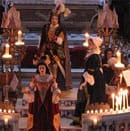A delicately crafted canopy, stretched by invisible threads above the altar moved for this exceptional occasion: a hovering shadow of divine protection as benevolent as a taleth spread by the patriarch over his family. Dozens of candles and tapers with flickering lights and nearly as many proud candelabras scattered all around the choir of the church: a scenic volume mixing imagination and fantasy. In front of a packed room already savoring the atmosphere of an evening not quite like any other, the musicians of the Nice Baroque Ensemble, celebrating its 25th year of existence this year, make their entrance and weave their way through this forest of candles.
Under the direction of Gilbert Bezzina, this Ensemble playing on period instruments begins the traditional three-movement overture—fast, slow, then fast again—of Alessandro Scarlatti’s Oratorio “La Giuditta”, performed for the first time in France since its creation at the end of the 17th century! In the pure tradition of the Oratorio, the work of this Neapolitan composer was performed last night in a sacred space, St. Augustine Church in Nice, during the Lenten period that banned opera considered too festive. The performance was punctuated, as it should be, by a sermon delivered at the end of the first part and solemnly read from the pulpit by Brother Benoît, the chaplain of the artists of Nice.
Three exceptional performers to embody the story of the young widow Judith, whose town of Judea, Bethulia, is besieged by the Assyrian troops. Inspired by divine guidance, she goes with her nurse to the enemy camp, manages to seduce General Holofernes, leader of the Assyrians, and beheads him in his sleep.
In the role of Judith, soprano Sophie Landy whose magnificent voice seemed intimidated by the sound recording of this production, risking the pinching of some highs or swallowing some syllables. She seemed “more comfortable during the dress rehearsal,” it was heard during the intermission. “Difficult,” explained this young mother after the performance, “to wear this dress as heavy as it is cumbersome and especially to move in a space reduced to a few square meters.” More convincing in his stage performance, endowed with a broader vocal range, tenor Carl Ghazarossian, playing the Assyrian general, offered to the audience a well-grounded voice, more modulatable in the emotional range, capable of moving from military triumph to romantic resignation. As for the countertenor, Raphaël Pichon, he literally transported the hall with delight during his aria “dormi,” reminiscent of the lullaby by which, according to legend, Delilah had put Samson to sleep before cutting his hair, the source of his strength.
Ultimately, a high-quality performance due to the synergy of all participants: a clever staging by Gilbert Blin, sufficiently suggestive by mere bodily expression without resorting—necessitated by the Oratorio—to too much physical movement of the artists. A director already appreciated in Handel’s “Teseo” produced last year by the Nice Opera and widely acclaimed. The Nice Baroque Ensemble was at its best, superbly carried by Gilbert Bezzina’s manifest passion for this repertoire, a sumptuous decor thanks notably to excavations undertaken in the church attic by Brother Benoît who discovered period furniture and old fineries, a flawless organization of this evening by the young administrator Mathieu Pérègne, and finally, diverse yet all moving voices in their respective qualities.


